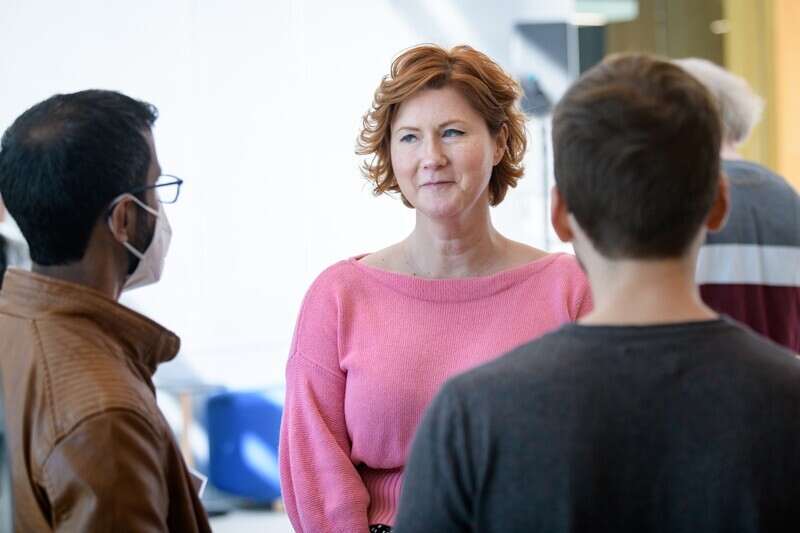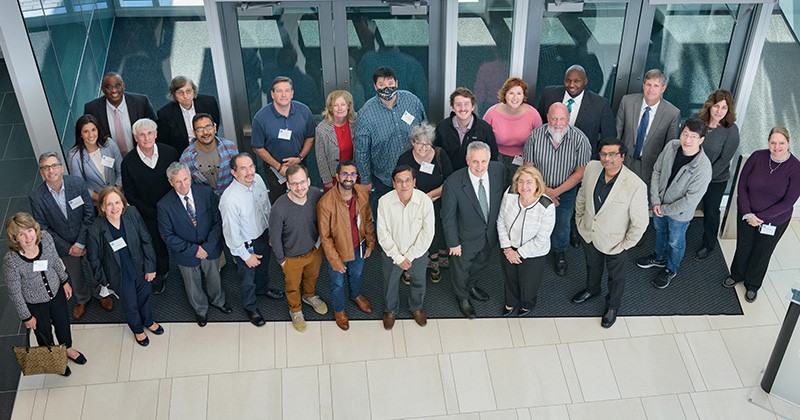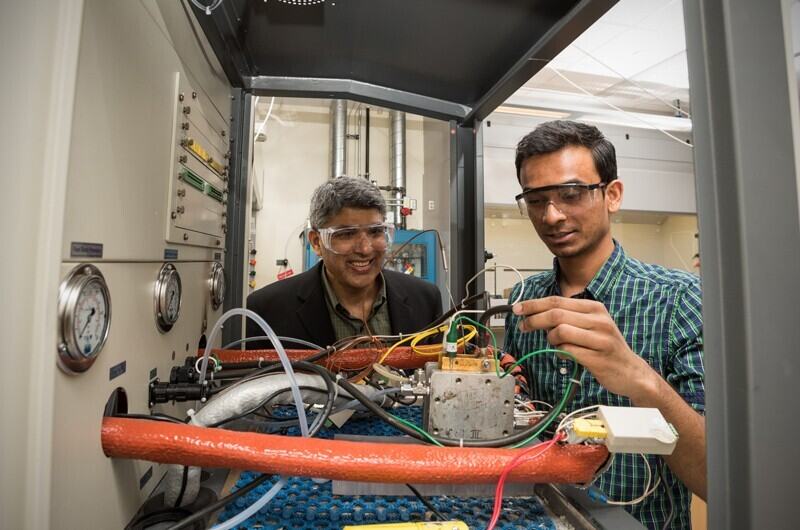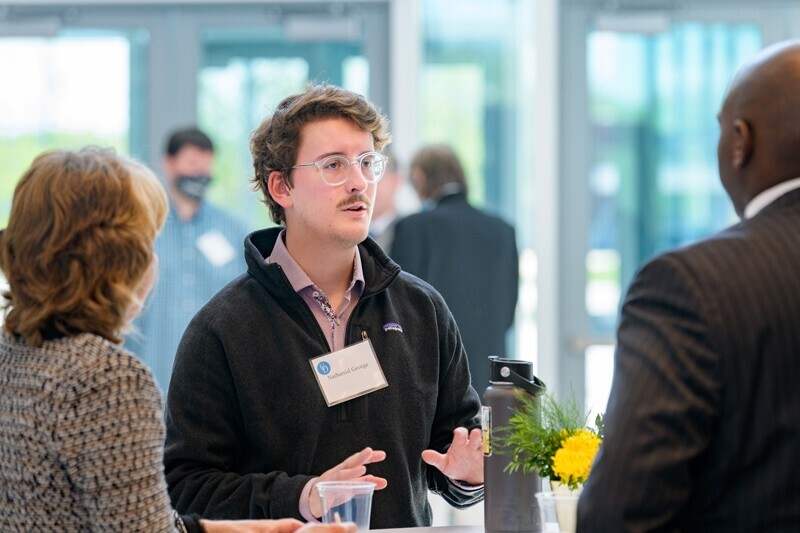University of Delaware honors campus inventors
Invention is rarely a straight line from idea to end product. More often, it is a circuitous route that involves iteration and failure. For inventors, however, finding solutions to societal problems is rewarding, no matter how hard-fought the process.
Take Martha Hall, director of innovation in the University of Delaware’s College of Health Sciences. Hall is creating wearable technologies for populations ranging from children with disabilities to stroke survivors to professional athletes.
In 2021 alone, Hall and her colleagues filed eight invention disclosures with the help of UD’s Office of Economic Innovation and Partnerships (OEIP) to protect ideas for everything from knitted personal protective medical masks to ankle braces, foot orthotics, compression sleeves and more.
So, where do these creative ideas come from?
“These projects come from many different sources, but they all address a critical need identified in the community,” said Hall. “Sometimes people, organizations or businesses contact the lab directly with health-related problems, but just as often our students bring problems to the lab based on personal experience or things they learn in class. I am so proud of the volume of innovative products coming out of the lab and that my students are involved in their creation and development.”

UD’s Martha Hall, director of innovation in the College of Health Sciences, and colleagues have invented a variety of wearable technologies to help children with disabilities, stroke survivors, professional athletes and more.
As the nation celebrates National Inventors Month in May, UD leadership honored the nearly 300 inventors — including Hall — on Monday, May 9, for their curiosity and courageous pursuit of innovation. The event was held in person for the first time since 2019 at the Ammon Pinizzotto Biopharmaceutical Innovation Center on the University’s Science, Technology and Advanced Research (STAR) Campus.
President Dennis Assanis welcomed UD’s inventors to the celebration and thanked them for creating a vibrant culture of exploration and discovery across the University’s campuses. Sponsored research spending has grown by more than 36% over the past decade, and UD is recognized as a top research university in the nation and worldwide.
“That kind of culture and those achievements don’t just happen on their own. They’re built and nurtured every day by our researchers and inventors, whether they work in a lab, in a studio, or in the field,” Assanis said.
Innovation = Impact
At UD, there’s no need to look far to find innovations that have an impact on society. “Redefining Creativity, Innovation and Entrepreneurship” is a pillar of the University’s strategic plan, and UD inventors are leading the charge.
Since 2012, UD researchers have generated more than 500 inventions and 125 patents, and 42% of UD patents during that time period have included a woman inventor. In fiscal year 2021, UD inventors secured 13 patents, licensed seven technologies and filed 32 invention disclosures to protect ideas in progress.
These new UD inventions have ranged from flexible solar cells to musical sonatas, ankle-foot orthotics, renewable lubricants and medical masks for protection against pathogens, according to Charles G. Riordan, UD’s vice president for research, scholarship and innovation.
“As inventors, you make our lives better, and sometimes you even save lives with the inventions you produce,” Riordan said, reflecting on the critical role that academic research has played nationwide in the continuing response to COVID-19, from designing protective equipment for front-line workers, to contributing key discoveries leading to life-saving treatments for patients, and establishing COVID testing operations like UD did, with the research community’s expertise.

UD leadership honored campus inventors for their courageous pursuit of innovation on Monday, May 9 at the Ammon Pinizzotto Biopharmaceutical Innovation Center on the University’s Science, Technology and Advanced Research Campus.
According to AUTM, the leading association in university technology transfer, over 900 products come to market each year from academic research.
One notable invention that got its start at UD is the ubiquitous touch-imaging technology found in today’s digital devices. The technology was created by UD professor John Elias and then-graduate student Wayne Westerman, two of UD’s 12 members of the National Academy of Inventors.
But there are others.
Avkin is a leading manufacturer of sensor-enabled, high-fidelity, wearable technology for health care simulation education established by Amy Cowperthwait, co-director of the Healthcare Theatre for the College of Health Sciences. Avkin’s patented devices allow health care workers and caregivers to practice complex care situations and clinical procedures, such as drawing blood, tracheostomy care, wound care, or catheter insertion, prior to encountering them at the bedside. The growing list of training tools offered by Avkin, includes a new birthing simulator that enables patient-centered simulation when worn by a live actor.
A species of beneficial bacteria known as UD-1022, developed by Harsh Bais, associate professor of plant and soil sciences, and Janine Sherrier, a former UD faculty member, is a microbial inoculant that promotes growth and protects plants against multiple diseases. Licensed by global chemical company BASF, the technology is available in the commercial market in several versions, boosting agricultural production for a growing world.
Other UD-patented research with potential includes natural algicides for controlling harmful algal blooms, clean energy technologies for removing carbon dioxide from air, new tools for understanding the immune system, research toward renewable alternatives to plastics and even improved materials for safer spacesuits, thanks to shear-thickening fluid (STF), a smart material co-developed by UD’s Norman Wagner and STF Technologies.
It starts with our inventors
At a recent UD Research Office Town Hall, held via Zoom on April 25, Joy Goswami, assistant director of OEIP’s Technology Transfer office, led a panel discussion with UD inventors Harsh Bais, Amy Cowperthwait and Ajay Prasad. Goswami started the discussion by appealing to all UD inventors to reach out early and often when they hit upon something with commercial promise in their research.
“OEIP’s technology transfer folks can help evaluate a potential invention, put some protection around it and help explore ways for inventors to take their technology innovations to market,” said Goswami.
Two major vehicles for doing this, he continued, include connecting inventors with companies that can bring the technology to market or assisting the faculty member or researcher in creating a startup around their invention.
Avkin’s Cowperthwait, for example, decided to pursue a startup company after learning that companies sometimes buy technologies to eliminate competition. She didn’t want that to happen with her team’s wearable technologies for patient-centered health care simulation.
“I firmly believed this was a much better way to train health care students, so I couldn’t imagine the technology sitting on a shelf. But it certainly wouldn’t have happened without university support,” said Cowperthwait, who also is a faculty member in the College of Health Sciences’ School of Nursing.

A costly failed part on UD’s hydrogen fuel cell bus led Professor Ajay Prasad (pictured left) and colleagues to devise a solution, prototype a new part and bring it to market through their own startup company.
Ajay Prasad had no idea when the first fuel cell bus arrived on UD’s Newark campus in 2007, that its presence would one day lead him and others to create a startup company. Within its first year of operation, however, a part on the bus called a hydrogen recirculator failed due to corrosion from contact with wet hydrogen. Replacing the part turned out to be cost prohibitive, so a master’s student in the Fuel Cell Bus team devised a way to passively recirculate the unused hydrogen for reuse. The team built and tested a prototype device and found it worked well, was highly corrosion resistant and consumed very little power.
“That’s when we realized we had developed a product that had some commercial value and potential, so we approached OEIP and filed a provisional patent application in 2010,” said Prasad, Engineering Alumni Distinguished Professor and chair of mechanical engineering.
As an academic, Prasad called the process “far easier than submitting a manuscript to a journal,” and today the patents related to the project are protected in North America, Europe and Japan, and the team’s startup company develops custom prototypes for automotive companies worldwide.
UD guidance and support to help facilitate the work of campus inventors of all kinds — researchers, faculty, students — extends beyond OEIP, too. Horn Entrepreneurship works side-by-side with OEIP to help students learn how to establish and run companies from successful entrepreneurs, and University-wide research institutes provide versatile expertise in data science, energy, the environment, biotechnology and biopharmaceuticals manufacturing. Strategic partnerships and infrastructure at the STAR Campus continue to grow to support UD’s innovation ecosystem, while state-of-the-art facilities elsewhere on campus continue to support research involving nanofabrication, biomedical and brain imaging and more.
This entrepreneurial infrastructure allows UD inventors to dream big with their own ideas, while also inspiring students to become the next generation of Blue Hen problem-solvers and entrepreneurs through their mentorship and dedication.
One of these students is Nate George, a junior neuroscience and biology double major. George is a co-inventor with Hall on a patent for a customizable orthotic boot for Achilles tendon injury, work the team is now extending to include technologies to detect and prevent pressure sores before they occur. George would like to one day work on the user experience side of biomechanics or health technology. He said his major, coupled with his experience creating inventions to solve the needs of real people, already has put him on the path to success.
“While it doesn’t directly translate to my area of study, businesses like when you have some background in the stuff your company actually handles,” said George. “This gives me a leg up, because I’ve done gait analysis, I know how invention works, and I can definitely help the customer because I’ve done it.”

Nate George, a neuroscience and biology double major, is a co-inventor with UD’s Martha Hall on a patent for an orthotic boot for Achilles tendon injury.
Article by Maddy Lauria | Photo by Evan Krape and Kathy F. Atkinson (featured on UDaily, 05/12/2022)
